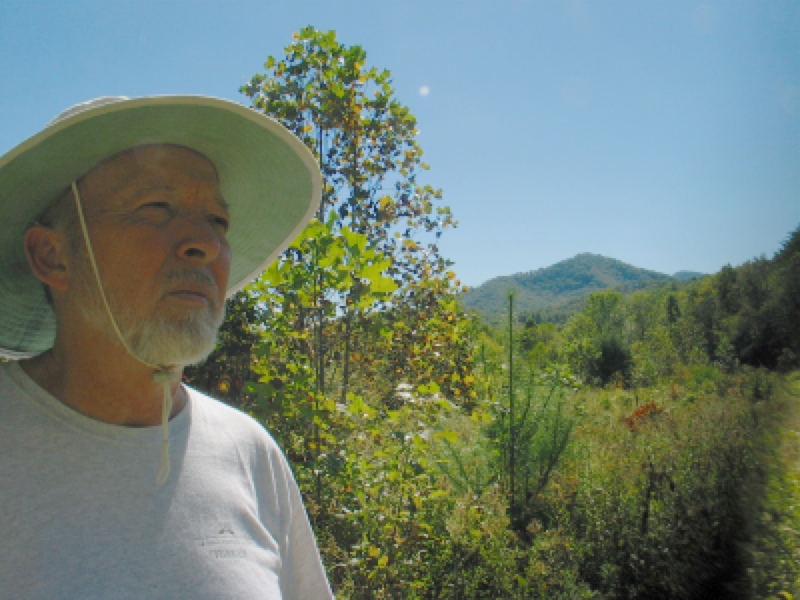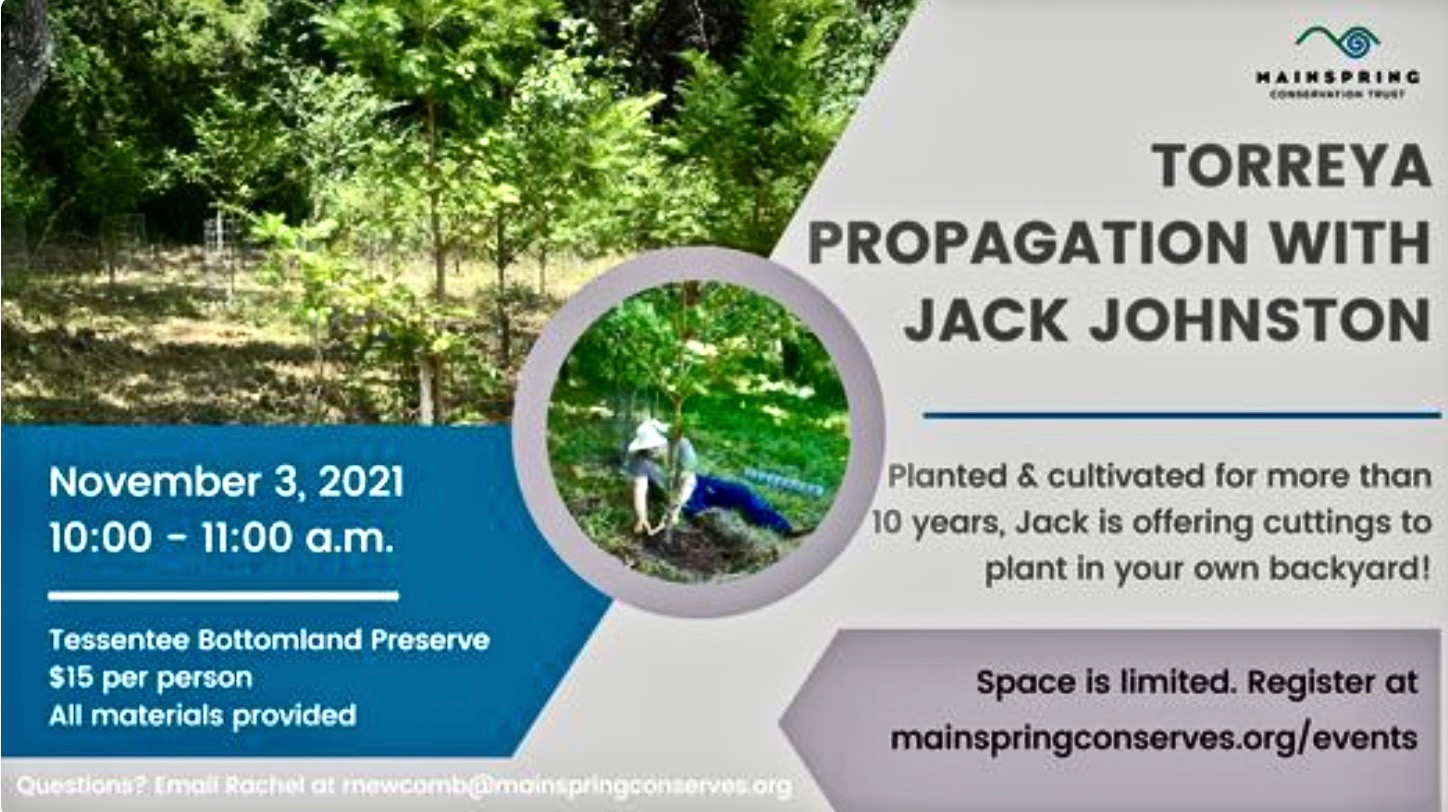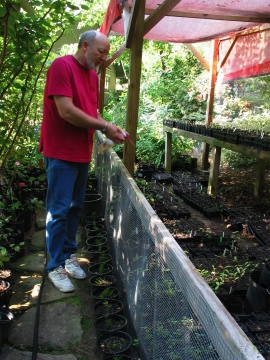

JACK JOHNSTON (above) is an avocational horticulturalist who propagates a variety of regionally native plants at his rural, mountainous home near Clayton, Georgia. Notice the row of black pots at his feet, on the exterior side of his shade-cloth-topped nursery (protection from the Georgia sun). You can see a close-up of the rooted cuttings of T. taxifolia branchlets that he is experimenting with, as it is far more difficult to successfully root a clipped branch than to germinate a seed or outplant a purchased seedling. Jack notes, "Cuttings of Torreya have either remained
green under shadecloth after spending the winter indoors for warmer temperatures, or
have died. Most have perished. The green cuttings have not flushed growth."
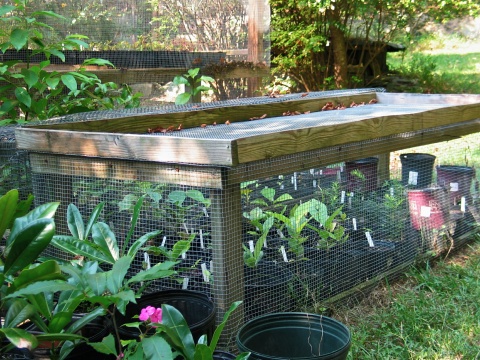 > >
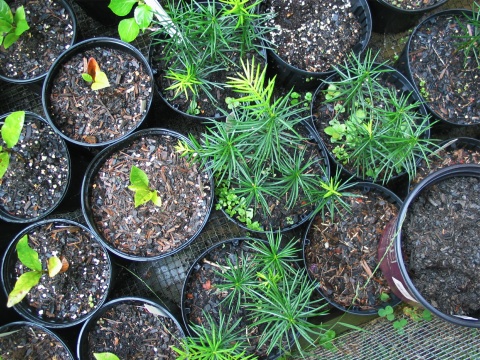
GERMINATING TORREYA TAXIFOLIA SEEDS: The surrounding 4 photos show Jack's method of germinating seeds. Because squirrels and smaller rodents find the seeds irresistible, Jack secures the pots of seeds in a shelter of tight metal screen, including underneath the pots. He puts about 5 or 6 Torreya seeds to a pot, just below the surface. These photos were taken by Connie Barlow in September 2010. The seedlings shown here sprouted from seeds harvested (still-green on the branches) in 2009, left in their casings one month to ripen, and then soaked to make the casing easier to remove. The naked seeds were planted in the pots autumn 2009. Jack notes, "I planted seeds in pots last fall and left them outside during the early part of winter, brought them indoors for several weeks, then took them out again [late February]. They seemed to come up okay but in low percentages [thus far]. My observation is that seedlings grow rapidly shortly after germinating." Jack says he watered the overwintering seeds in his basement "a little" to keep them moist, but he was concerned that too much water might result in their rotting. He reports that light freezes occurred before in the fall and early spring when the pots were outdoors.
LOWER RIGHT: The yellow arrows point to 2 Torreya seeds that have not yet germinated in a pot in which 4 others already have. Experience, and the advice of conifer experts, urges one to be patient with Torreya seeds: seeds from the same crop may germinate anywhere from 6 months to 2 or 3 years. "The most important thing is to keep the seeds moist," notes one advisor. Because the pots are above ground, Jack moves them into his cold basement each winter. Note: For more advice on seed propagation click here.


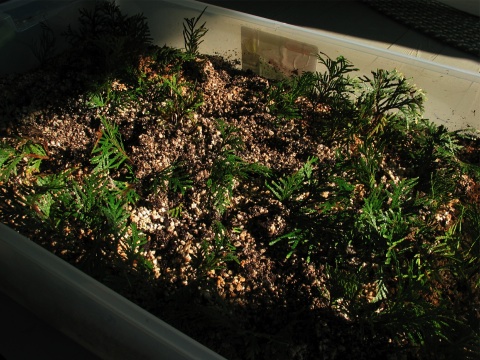

UPPER LEFT: Jack is now attempting to root Arborvitae (Thuja occidentalis) native conifers in the same clear plastic, roofed container that he used to keep Torreya branchlets moist during the rooting process. Perlite is the substrate, but Jack notes that he had little success once the rooted branchlets were transferred to pots and then later outplanted. He thinks that perhaps they must remain longer in the pots, and then it is important to shake the perlite off the roots before outplanting into soil.
UPPER RIGHT: Most of the outplanted Torreya taxifolia planted on Jack's semi-open, west-facing mountain slope, were purchased from a nursery as well-established potted seedlings. The arrows mark top and bottom of 2 such plants visible in this photo. Jack has learned from experience that commercial fertilizer can damage the seedlings, so he now uses worm casing compost to enrich the immediately surround soil.
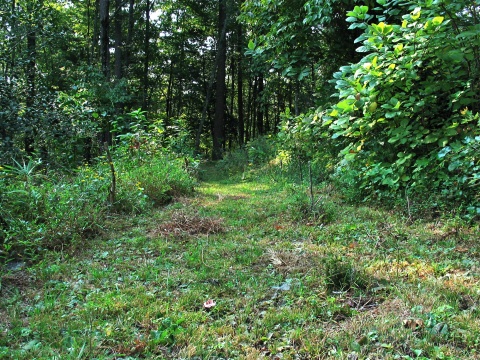

Once the seedlings establish as outplantings, Jack will periodically lime them and also water them in dry times. All but one of the outplanted Torreyas in Jack's yard as of September 2010 were purchased as potted seedlings from a nursery. The sole exception is an outplanting from a 2007 seed harvest, which was Jack's first attempt to germinate seeds. Because voles managed to destroy so many of those seeds, which were planted directly in the ground, though netted on all sides, all of his 2009 seeds were put into pots first, and then protected by metal mesh.


UPDATE: April 2012 Jack reported, "Just lost 4 of my old Torreya to voles! They eat the roots and the bark well up the stems."
UPDATE: May 21, 2012: "Torreya are starting to come up from seeds
planted fall of 2011." May 30, 2012: "For some reason Torreya germination seems to have stopped, but if true to the pattern of previous years may continue until August! All seeds are vole-protected in a wire cage, and I'm watering the pots as needed."
UPDATE: November 3, 2012: "Germination of my seeds was late this year.
My grove here at the house had 3 vole losses; I have replanted 2 of
the spots. Total plants on my property now number 24, I believe. Four seedlings (from previous years seeds germinated) went to John Tobe at Franklin, NC."
UPDATE: November 2014: "I have 24 trees in my yard but it remains to be seen if voles will allow them to continue growing. The tallest is 5 feet and is some years away from seed set. I'm in Rabun County, GA, county seat is Clayton — the NE county of the state which borders SC and NC. Torreya seems to grow fine here."
UPDATE 2021: Jack Johnston presents on his Torreya planting at Tessentee Bottomland Preserve along the Little Tessentee River, NC.
|



 >
>









